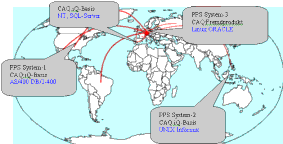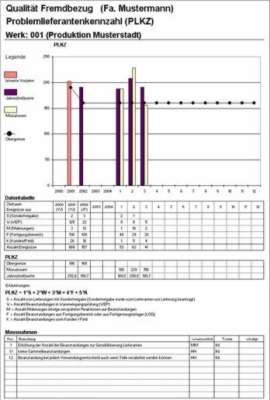Globales Q-Informations-System

Die Qualitätssicherung hat die Grenzen der Fachabteilung schon lange überschritten, jetzt streben große Unternehmen nach
einem konzernweit einheitlichen Qualitätsmanagement.
Unter Berücksichtigung der aus vielen historischen Gründen gewachsenen heterogenen DV-Landschaft, mit unterschiedlichen PPS- und
CAQ-Systemen in den Werken, haben wir mit iQ-GQMS ein Modul entwickelt, dass für das Qualitäts-Management
von der Konzernspitze bis in die Fachabteilung
umfassende Informationen für strategische und operative Entscheidungen bereithält. Die Flut der Qualitätsdaten wird durch geeignete Verdichtungsstrategien zur
Auswertbarkeit aufbereitet.
Die Hierarchieebenen eines Konzernes aus der Sicht Qualitätsmanagement:
- Werker: zur Führung und Überwachung stabiler Prozesse
- Q-Fachabteilung: systematische Prozessabweichungen, Beurteilung von Zukaufteilen, zustandsorientierte Instandhaltung
- Werksebene: Einschätzung der Lieferqualität, eigene ppm-Qualität beim Kunden, Auditierung Qualitätsvorausplanung (APQP, PPAP, FMEA usw.)
- Geschäftsbereich: Austauschbarkeit von Qualitätserfahrungen zwischen den Werken, werksgenaue Q-Management, Auslagerung von Fertigungsprozessen mit allen Q-Informationen
- Konzern: eine Lieferantenbewertung für alle Werke, zentrale Qualitätslage bei allen Kunden, umfassende Investitionen für die Qualitätsverbesserung
Anforderungen an ein globales Management-System
- Zusammenführung aller Q-Informationen aus weltweit verteilten Standorten, mit unterschiedlichen PPS- und CAQ-Systemen
- Beschaffung von Q-Informationen aus beliebigen DV-Architekturen (DB-Server, wie ORACLE, Informix, DB/400, MS-SQL-Server usw. und Betriebssysteme, wie AS/400, Unix, MS-NT usw.)
- Zusammenarbeit mit beliebigen CAQ-Systemen auf einem kleinsten Nenner (Lieferqualität, eigene Fertigung, Kundenbeanstandungen)
- Erfassung von Produktionsdaten (Artikel, Fertigungsdatum, ausgelieferte Menge)
Der fachliche Informationsbedarf und Austausch zwischen Werken
- welches Werk betreut Lieferant A, wie waren die letzten Audits
- wie ist seine Liefer- und Mengentreue, der Service, die Preisflexibilität über Artikel, Produktgruppen, insgesamt
- wie ist die Qualität seiner Dienstleistung, Erstmuster, Nullserien, Abwicklung aus Beanstandungen, Dokumentationen
- wieviel Kundenbeanstandungen weltweit sind auf Lieferungen von Lieferant A zurückzuführen, Folgekosten aus Fehlern
- Konsequenzen gegen den Lieferanten bei Unterschreiten der Qualitätsziele
- Probleme des Werkes A bei der Einführung eines neuen Prozesses, der im Werk B auch eingeführt werden soll
- Prozess-Instabilitäten auf Maschinen eines Herstellers
- Instandhaltungs- und Instandsetzungskosten für ähnliche Maschinen
- Qualität von Prüfmitteln eines bestimmten Herstellers
Der strategische Informationsbedarf auf Konzernebene
- wie sieht unser Kunde unsere Qualität, gemittelt über alle Werke
- welches ist das schlechteste Werk
- welches ist die eigene Sicht bezogen auf den Kunden
- welches sind unsere Dienstleistungsprobleme
Die Aufbereitung der Qualitätsdaten
Qualitätsdaten entstehen auf der untersten Ebene
- Urwerte durch Messungen
- attributive Fehlerangaben
- Ausschussermittlungen
- Prozessstörungen, Maschinenstillstände usw.
Die Daten sind für höhere Ebenen (Werk, Konzern) zu verdichten:
- cpk-Werte gemittelt über Tage, Wochen
- Monatsstatistiken zu Ausschussmengen, ppm-Angaben
- Artikelübergreifende Fehlerstatistiken für gleiche oder ähnliche Prozesse
- Qualitätskennzahlen eines Lieferanten monatlich/ jährlich
- monatliche Kosten durch Maschinenstillstände usw.

In iQ-GQMS erfolgt die Datenkumulation nach groben Auswertungszielen.
Die Daten werden in möglichst einfachen Speicherungs-Strukturen, die durch den Anwender definiert werden können, abgelegt, z.B. für Monatsstatistiken:- gelieferte Mengen, verbaute Mengen
- Anzahl Lieferungen, Lieferungen mit Sonderfreigabe
- Beanstandungen aus Wareneingang, Fertigung, Kunde, 0km, Feld
Die Auswertungen lassen sich aufgrund der einfachen Strukturen auch einfach entwickeln, die Performance für die Erstellung eines Reports ist DV-technisch optimal.
Die Datenextraktion
- aus den operativen Daten, z.B. aus einer Kundenbeanstandung, werden alle auswertungsrelevanten Daten extrahiert
- es wird eine Verdichtungsstrategie mit bis zu 20 Selektionsfeldern festgelegt
- Festlegung möglicher Selektionsfelder (Zeitraum von bis, Kunde, Materialgruppe, Material, Werk usw.)
- Form der Verdichtung (Mengenfelder kumulieren, Ereignisse zählen, Berechnung von Mittelwerten, Min., Max. usw.)
iQ-GQMS ist in der Lage, bei nachträglichen Änderungen bzw. bei Stornierungen der operativen Daten die verdichteten Daten zu korrigieren.
Auswertungen
Auswertungen können mit allen marktgängigen Produkten wie EXCEL, Crystal, Business Objects vom Anwender selbst erstellt werden.AHP fügt ständig neue Auswertungen hinzu.
Das Beispiel beschreibt die ppm-Fehlerrate über Zukaufteile eines Werkes. Die ersten drei Jahre werden zusammengefasst, das Jahr 2000 monatsgenau aufgeschlüsselt. Die gesetzten Ziele können vorgegeben werden.
